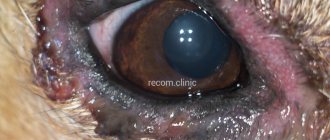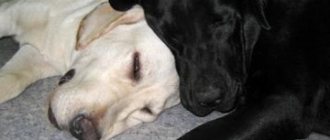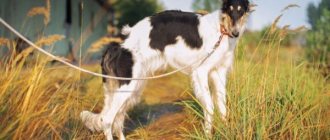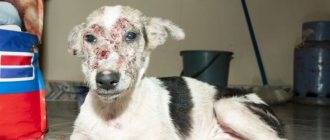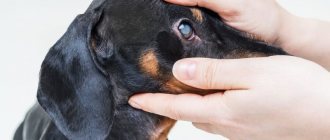Content
1. What is this extremely dangerous disease 2. Infectious hepatitis 3. Symptoms of adenovirus 4. Characteristic features of the course of the disease 5. How a dog becomes infected 6. Characteristic features of diagnosis 7. How treatment for adenovirus infection proceeds 8. Let’s summarize
The health of a small puppy or an adult dog is the responsibility of the owner, care and attention that is shown from the first day of the animal’s life in a new family. There are many common threats in the environment that can negatively affect the body. And adenovirus infection, with the connivance of the dog’s owner, even becomes a cause of death. Therefore, every owner of a small puppy or adult dog should know all the main symptoms of adenovirus, be able to recognize them and, after making an accurate diagnosis, organize and carry out comprehensive, effective treatment.
Prevention
Prevention of infection with viruses is vaccination. For adenovirus 1 it is carried out for puppies at 6–8 months. They should receive 3 doses 1 month apart. Vaccination of an adult dog is carried out in 1-2 doses, depending on the type of vaccine used.
Traditionally, dogs are vaccinated annually. But at the moment there are studies proving that the vaccine forms immunity lasting 4 years. Therefore, the recommended schedule for vaccinating your pet should be clarified directly at the veterinary clinic.
As for adenovirus-2, for example, in the United States over the past 15 years, only one case of infection of a domestic dog has been reported. Therefore, it is possible to vaccinate against adenovirus type 2, but it is not mandatory.
What is this extremely dangerous disease?
Adenovirus in dogs is an infectious disease, extremely dangerous, occurring with significant complications, deterioration in the well-being and general condition of the animal. Adenovirus spreads exclusively by airborne droplets and most often affects young puppies. At the same time, cases of infection of this disease in adults, especially old pets, are often recorded.
It is important for the owner of the animal to understand the symptoms in a timely manner, to understand that his four-legged friend is sick precisely because of an adenovirus infection. This will help not only to correctly recognize the disease, but also to formulate an optimal treatment program, providing all the necessary medical care in a timely manner. Everything is simple here: the faster the reaction to the disease, the greater the chance of full recovery and recovery of the animal.
It is necessary to realize that adenoviral infection can manifest itself in one of two forms:
- Infectious hepatitis.
- Adenovirus.
These two types of diseases belong to the group of infectious diseases. The nature of transmission from one individual to another is by airborne droplets. Triggering and progression occurs under the influence of two different causative viruses (CAV-1 and CAV-2). Let us consider these varieties in more detail, since proper treatment often depends on the ability to correctly identify the symptoms of adenovirus.
Clinical picture and diagnosis
From the moment of infection until the first clinical signs appear, 4-7 days pass. The upper respiratory tract and conjunctiva are primarily affected. The disease is accompanied by coughing, sneezing, and bilateral nasal discharge. The mucous membrane of the eye becomes red, lacrimation increases, photophobia appears, and dogs often scratch their eyes.
3-5 days after the initial symptoms, the course of the disease becomes more complicated. The cough becomes frequent, dry, and painful. The exudate changes from catarrhal to purulent. Dogs are depressed, their response to external stimuli decreases, and their appetite is lost. The greatest changes occur in the respiratory organs - the bronchi, trachea, pharynx, and tonsils become inflamed. When examining the pharynx, redness is revealed, and overlaps are possible. Hyperthermia can appear already on the 2nd day of illness; usually the temperature does not exceed the norm by 1 degree.
Without treatment and in weakened animals, the digestive organs gradually become involved in the pathological process:
- loss of appetite;
- vomiting appears, sometimes with blood;
- stool becomes watery, sometimes mixed with mucus and blood.
The clinical picture of canine adenovirus is similar to many diseases. It is necessary to carry out differential diagnosis for plague, infectious hepatitis, rhinotracheitis, chlamydia, and non-communicable respiratory diseases. To clarify the diagnosis, it is necessary to analyze the blood serum for the presence of specific antibodies. Diagnosis is carried out using the associated compliment reaction, enzyme immunoassay, and hemagglutination. The diagnosis is considered established when the antibody titer increases more than 4 times.
Infectious hepatitis
This disease manifests itself in a particularly acute form, severe for a pet. The incubation period lasts quite a long time - up to 14 days inclusive. All this time, the virus remains in the body, continuing to have a negative effect on the internal organs, respiratory tract, worsening the general condition. The contagious virus is extremely resistant to the external environment, and to completely defeat it will require patience and strict adherence to all medical recommendations.
Here's a simple example:
At an ambient temperature (in the house and outside) of at least +4 degrees, the virus can continue to reside in the animal’s body for up to 9 months. This means that a dog previously infected with adenovirus will spread the infectious disease in all the places where it was. Infected bacilli will remain extremely dangerous throughout the autumn-winter period.
Thus, any healthy individual that finds itself outdoors in an area where an adenovirus infection is spreading can become infected. And even if strong immunity allows you to resist the progression of the disease, the transmission of bacilli will only increase.
And it is extremely difficult to resist the virus, despite all the latest achievements of modern medicine and veterinary art!
Symptoms of adenovirus
The main signs indicating that the dog is infected with an adenovirus infection (namely, infectious hepatitis):
- A sharp increase in body temperature, up to 40 – 41 °C.
- Fever, feverish condition.
- The pupils of the eyes become cloudy, and a white coating forms on the eyes. These are symptoms of a dangerous disease called keratitis. Such a terrible and dangerous defect can be eliminated only after long-term complex treatment for adenovirosis.
- The dog's appetite sharply decreases, the animal refuses to eat at all or eats very little.
- There is constant malaise. General lethargy. The animal becomes passive, lazy, and does not want to lead the same active lifestyle.
- There is pain in the abdominal area, any touch. Even gentle stroking is unpleasant and extremely painful for your pet.
CAV-2, the adenovirosis virus, manifests itself differently. This type of disease manifests itself as an infectious cough (tracheobronchitis). If you miss the moment and do not carry out timely treatment, there is a danger of developing chronic bronchitis with all the ensuing negative consequences of the adenovirus. It should be noted that adenovirus is less dangerous to the dog’s health than infectious hepatitis; as a rule, the animal does not face death (such cases are recorded extremely rarely). A dog that has been successfully treated for the CAV-2 virus is immune to a variety of mild illnesses that may have been common before the adenovirus infection.
Signs of adenovirus infection are similar to canine distemper. It is important to diagnose correctly. It is recommended to pay attention to symptoms characteristic of adenovirus, such as:
- Persistence of cough for a long time.
- High intensity cough, up to vomiting.
- Strong nasal discharge, other abundant mucous formations.
- Dyspnea.
- It is important that the body temperature during adenovirus remains within normal limits.
Treatment of adenovirus in adult dogs
Treatment is carried out only by a veterinarian - this is an axiom. There are no specific drugs against the disease, so drugs are prescribed that relieve symptoms and support immunity.
List of actions for CAV 2:
- drugs that soften mucus are prescribed: Mucaltin, Bromhexine, Libexin and expectorants;
- carry out inhalations that help ease breathing;
- A course of immunomodulators that enhance immunity is required.
The most irritating factor is coughing, so all primary efforts are aimed at eliminating it. When the lungs are damaged and a secondary infection (bacteria) joins the main disease, antibiotic tablets, sprays with kanamycin, and gentamicin are used.
Cold and dampness worsen symptoms, so a dog with an adenovirus infection should be placed in a warm, dry place. Drink and food are only warm.
From the first days of illness, antiallergic drugs are sometimes prescribed; if the gastrointestinal tract is affected, the dog is transferred to a gentle feeding regime with Regidron, Vikalin, Almagel, in order to prevent deterioration of the condition and the development of dehydration. Probiotics and enzymes help improve the functioning of the stomach and intestines.
Droppers are indicated to eliminate intoxication and improve heart function.
For adenovirus type 1, there are no drugs that would immediately suppress the effect of the virus and cure the disease. Antibiotics are used to prevent the development of bacterial infection, immune serum, immunomodulators and supportive care.
Important! A favorable result is expected only with timely treatment. When the dog becomes infected with the adenovirus, a strong immunity is formed, but the dog remains a carrier of the infection for another 2 years. This must be taken into account when placing other dogs near her in an enclosure or walking outside with other pets.
Features of treatment for puppies
In puppies, it is better to prevent the virus than to treat it. For a fragile body, infectious hepatitis can cause death. Timely vaccination will be a good option for preventing the disease. In case of illness, medications are used that can help support the body and eliminate symptoms.
Compliance with the conditions for keeping a sick puppy: warmth, absence of dampness and good nutrition will help defeat the disease.
Characteristic features of the course of the disease
Both the first and second types of viruses begin damage to the pet’s body by affecting the tonsils (it is known that they are located in the dog’s mouth and cover the entrance to the throat). Active reproduction of the virus occurs in the tonsils, and from here it travels along with the blood to all the most remote points and places of the body. The virus first of all attacks the liver, affecting more and more of it from the inside; the dog’s kidneys and eyes also suffer. However, there may be no visible symptoms of adenovirus at the initial stage. The owner’s task is to carefully examine the mucous membrane of the eye, and identifying signs of conjunctivitis may indicate the initial stage of the disease or, at least, that the virus has already entered the animal’s body.
In this situation, the state of the dog’s immunity plays an important role in counteracting adenovirus. If it is strong enough, then the body copes with the virus on its own, without outside help. And in this case, adenovirus disease will not occur. Moreover, a strong and healthy body can completely defeat a contagious infection and not leave the slightest trace. However, completely relying on a favorable outcome is risky. The fact is that adenovirus microorganisms can remain latent in the animal’s body for up to 9 months and not manifest themselves in any way. And all this time the dog will remain a potential threat to its surrounding relatives.
Two main categories of pets are most susceptible to adenovirus infection:
| First | Puppies that have not reached sexual maturity. Their age, as a rule, does not reach 1 year. The second is almost all dogs that were not vaccinated in a timely manner in accordance with established rules. |
| Second | Almost all dogs that were not vaccinated in a timely manner in accordance with established rules. |
It is also important to realize that the infection can affect any dog, regardless of age and gender, breed and health status. To a large extent, the owner of the dog bears responsibility for the health of the pet, timely preventive measures, and protection against adenovirus infection.
How does a dog become infected?
In any case, the adenoviral symptom will manifest itself when the infection is transmitted by airborne droplets. This means that the harmful bacteria of adenovirus enter the body of a healthy dog through direct contact with the dog carrying the adenovirus. Contact can occur during the first acquaintance, joint games, mating, etc.
We should not forget that the virus bacteria continue to remain viable in low temperatures, so if a dog sniffs the feces of other animals left on the street, this can also trigger the onset of adenoviral disease. Moreover, according to veterinarians, the infection spreads most actively in this way, through the infectious excrement of dogs infected with adenovirus.
What places are the most dangerous for your pet? Where do animals most often come into active contact with each other and can become infected with adenovirus? Below is a list of the most popular such places:
- Dog shows.
- Vet clinic.
- Yard area or play area for animals.
- Kennel club.
- Other dog walking areas, pet stores and kennels.
It should be understood that if you let your pet go far away from you and without a leash, and do not monitor what it sniffs, licks or puts in its mouth, the likelihood of transmitting contagious symptoms of adenovirus will increase sharply.
Characteristic features of diagnostics
Diagnosing adenovirus infection is quite difficult. The main reason for this is the similarity of the symptoms of adenovirus with other similar types of diseases. It is possible to accurately establish that an animal’s body is infected with a dangerous virus and to distinguish between CAV-1 and CAV-2 only after a full examination at a veterinary clinic and passing tests, such as:
- blood test for anderovirus;
- Analysis of urine;
- stool analysis;
- X-rays of the abdominal cavity;
- liver examination (increase in size is a clear symptom of adenovirus).
How is treatment for adenovirus infection performed?
The first, mandatory stage of treatment for adenovirus is a visit to the veterinarian, a full examination, and a qualified consultation with a veterinarian. Only an experienced specialist is able to understand all the intricacies of this dangerous, but rather thinly disguised disease.
As a rule, treatment, preventive and restorative measures are prescribed and carried out at home. And only if adenoviral pneumonia is detected may require hospitalization. The main treatment for adenovirus is to create conditions of complete rest, the animal is provided with plenty of fluids, and the most gentle diet is organized. The main treatment is a course of antibiotics prescribed by a veterinarian. Intramuscular injections are given daily for 10 days. If necessary, the course is repeated until complete recovery. Improvement in condition is assessed by the restoration of normal breathing, activity, and improved appetite. This all suggests that the threat of adenovirus infection was overcome and the animal began to recover.
Treatment
A sick dog should be treated as follows:
- To increase the body's resistance, various immunostimulants (immunomodulators) are used. The basis is human immunostimulants, such as anti-influenza, anti-measles immunoglobulin, as well as a drug such as Interferon.
- Immunoglobulin is injected subcutaneously at 0.5 or 1.5 ml once for 3 days (also administered intramuscularly).
- Using a disinfectant solution, eliminate discharge from the eyes and nose using a solution of potassium permanganate, boric acid, furatsilin, as well as decoctions and infusions of medicinal herbs.
- Dietary food consisting of easily digestible and finely ground feed is prescribed; boiled feed with a high content of vitamins (A, B, C, E) is also offered.
- A sick dog must be given multivitamin preparations (separate groups of vitamins B and C are administered subcutaneously, intramuscularly or intravenously).
- By prescribing appropriate antibiotics, the secondary (secondary) microflora is suppressed .
Important! The entire treatment process is determined by the veterinarian.
Seek advice only from a specialist - do not self-medicate.





